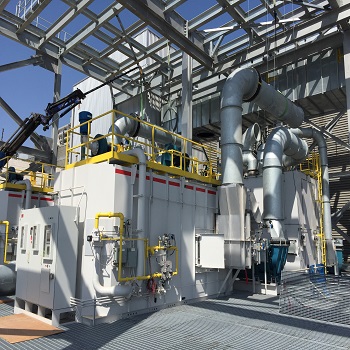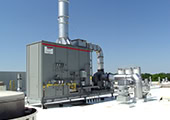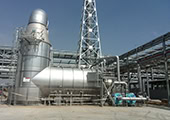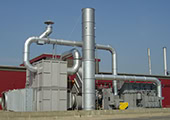 The Anguil Thermal Recuperative Oxidizer destroys Hazardous Air Pollutants (HAPs), Volatile Organic Compounds (VOCs), and odorous emissions discharged from various industrial processes using thermal oxidation and heat recovery.
The Anguil Thermal Recuperative Oxidizer destroys Hazardous Air Pollutants (HAPs), Volatile Organic Compounds (VOCs), and odorous emissions discharged from various industrial processes using thermal oxidation and heat recovery.
Anguil’s thermal recuperative oxidizers incorporate flexible heat exchanger arrangements, from cleanable tubes ideal for applications with particulates, to shell side exposure combined with soot blowers for silicone dioxide (SiO2) applications. The heat exchanger also minimizes the system’s fuel consumption with the system being self-sustaining at moderate Lower Explosive Limits (LELs).
-
Product Overview
Benefits of Anguil’s Thermal Recuperative Oxidizer
- Proprietary Tube Heat Exchanger Design
- 99.9% Destruction Efficiency
- Exceptional cleanability with access doors to clean both tube and shell side of exchanger
- Pressure monitoring for predictive maintenance
-
Air Flow Range & Efficiency
Air Flow Range
- 10,000-35,000 SCFM (16,050-56,175 Nm3/hr) (Single Unit)
Destruction & Removal Efficiency
- 99.9%+
Thermal Energy Recovery
- 50-70%
-
Ideal Applications
Ideal Applications
- High emission concentrations
- Capital cost limitations
- Process heating needs
- Particulates like silica in the airstream
FEATURES AND DESIGN OPTIONS
Features
- Reactor has ceramic lining, high density insulation and painted steel weatherproof enclosure
- A multiple pass, 309L or 321L stainless steel, shell-and-tube heat exchanger, with flexible arrangements available
- In-line burner designs
- Gas trains are designed to meet FM Global or any international certifications such as CSA, EN, TSSA, CGA and ATEX
- FM approved modulating burner can operate on either natural gas or propane
- Burner designed to maintain temperature during full flow, no VOC process conditions
- Robust Programmable Logic Controller (PLC) based controls with digital data recording, remote telemetry and various configuration options.
- Variable Frequency Drive (VFD) allows for high volumetric turn-down during idle or low process conditions
 Options
Options
- Specialty designs for silicon bearing compounds and particulate matter
- Higher alloy heat exchangers for corrosive applications
- Modulating damper and heat exchanger by-pass prevent over temperature concerns for high concentrations situations
- Alternative heating options including electric and multiple gas fuel inputs (natural gas, propane, hydrogen) and ultra-low NOx
- Acid gas scrubber module with a completely integrated control system
- Secondary heat and energy recovery solutions for process heating needs
- Custom oxidizer design options to meet space restrictions
Operating Cost Reduction Strategies
- Primary or secondary heat and energy recovery solutions
- Recirculation Systems
- Oxidizer Service and Preventive Maintenance Evaluations (PME)
How Does the Thermal Recuperative Oxidizer Work?
The Thermal Oxidizer is designed based on volume of airflow, organic vapor concentrations and desired destruction efficiency. During operation, HAP and VOC laden air is drawn into the system fan and discharged into the inlet where it is preheated in the tube side (typically) of a shell-and-tube style heat exchanger. Contaminated air then passes by the burner where it is raised to the thermal oxidation temperature (1,450-1,800ºF / 650-1,000ºC) for the specified residence time (0.5 – 2.0 seconds) and an exothermic reaction takes place. The pollutants are converted to carbon dioxide, water vapor and heat within the reactor chamber.
The hot, purified air then passes again through the shell side (typically) of the heat exchanger where the energy released by the reaction is used to preheat the incoming air. The heat exchanger minimizes the system’s fuel consumption with the system being self-sustaining at moderate Lower Explosive Limits (LELs). Finally, the contaminant-free air is exhausted into the atmosphere.
Applications which carry silicones may have the configuration reversed, allowing the hot silicone laden air to pass through the tube side of the heat exchanger after the burner for maintenance and cleaning.

 Options
Options








